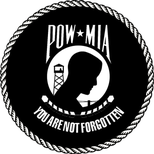POW-MIA Flag Origin - American Legion Post #40
Main menu:
POW-MIA Flag Origin
Special Interests
ORIGIN OF THE POW/MIA FLAGThe National League of Families’ POW/MIA flag symbolizes the United States’ resolve to never forget POWs or those who served their country in conflicts and are still missing.There are 1,741 American personnel listed by the Defense Department's POW/MIA Office as missing and unaccounted for from the Vietnam War, as of April 2009. The number of United States personnel accounted for since the end of the Vietnam War in 1975 is 841. About 90 percent of the 1,741 people still missing were lost in Vietnam or areas of Laos and Cambodia under Vietnam's wartime control, according to the National League of Families website (cited in the United States Army website).Newt Heisley designed the flag. The flag’s design features a silhouette of a young man, which is based on Mr. Heisley’s son, who was medically discharged from the military. As Mr. Heisley looked at his returning son’s gaunt features, he imagined what life was for those behind barbed wire fences on foreign shores. He then sketched the profile of his son as the new flag's design was created in his mind.The flag features a white disk bearing in black silhouette a man’s bust, a watch tower with a guard on patrol, and a strand of barbed wire. White letters “POW” and “MIA”, with a white five-pointed star in between, are typed above the disk. Below the disk is a black and white wreath above the motto “You Are Not Forgotten” written in white, capital letters.
Have questions or comments? We welcome your opinion. Please email your comments or suggestions to webmaster@lanesboroamericanlegion.org or call Anne at 507-460-9040. Thank you for your support.


